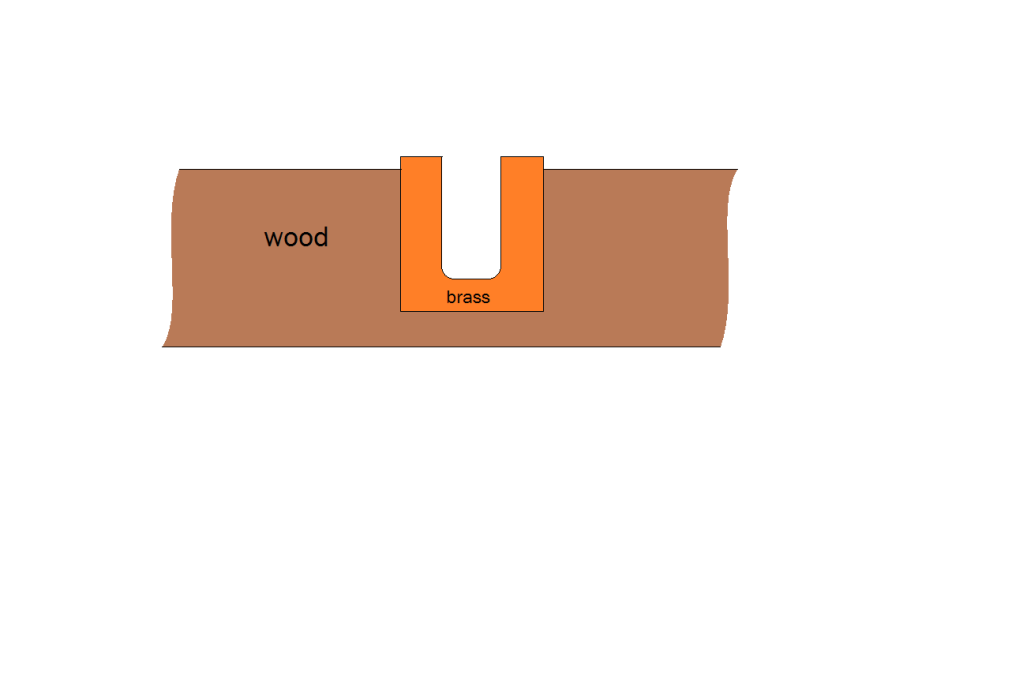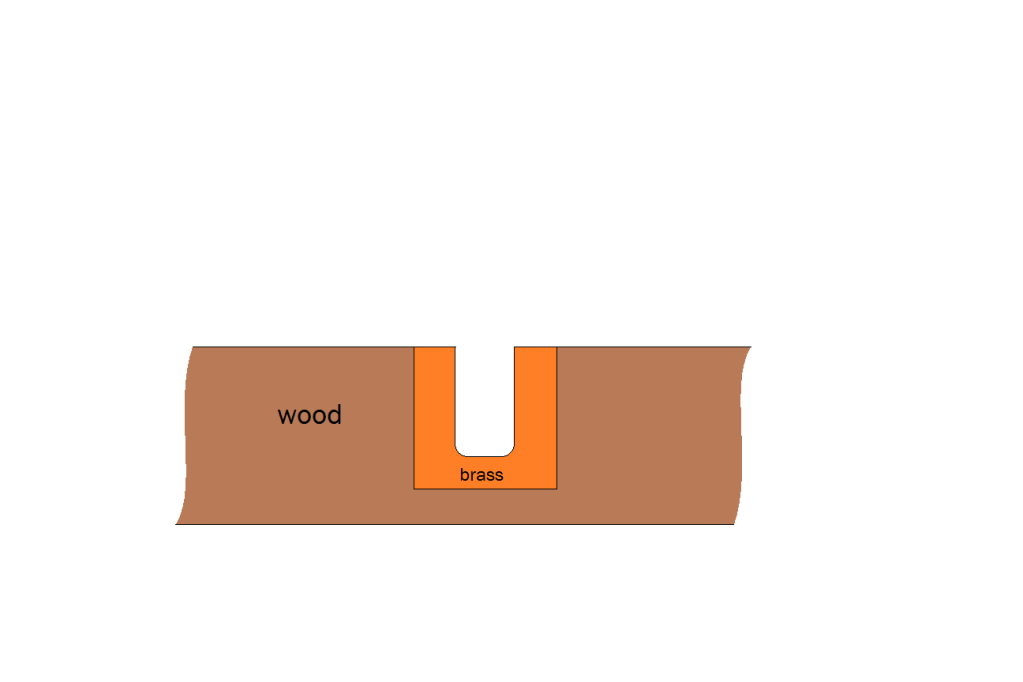 Thanks: 0
Thanks: 0
 Likes: 0
Likes: 0
 Needs Pictures: 0
Needs Pictures: 0
 Picture(s) thanks: 0
Picture(s) thanks: 0
Results 1 to 15 of 31
-
13th December 2011, 09:05 PM #1
 Novice
Novice











- Join Date
- Dec 2011
- Location
- Frankston
- Posts
- 10
 New member looking for appropriate tool/fitting
New member looking for appropriate tool/fitting
Hi all,
I'm totally new here and inexperienced in metalwork. I have a particular job I want to do which I am hoping I can do with a power drill and the right fitting. I have searched online for the right type of drill fitting, but cannot find anything suitable. If such a fitting exists, I would not even know what it is called.
I have a guitar with brass studs inserted in mahogany. The studs sit about 3/16" proud of the wood and I want to grind one of the studs down until it is flush with the body. The purpose of this is so the bridge will sit lower and I can avoid an expensive neck re-set.
I've attempted a drawing to clarify:
In profile the stud is like this:

and I want it to look like this:

In my hopes, there is a drill attachment with a flat grinding face and a central guide that would allow me to insert it into the hole in the stud so that the grinding surface grinds only the top? Something like a spade bit, but in 3D, rather than having two cutting surfaces. A bit hard to explain so have tried to represent in a drawing - here is what I am visualising:

The pictures do not display in the post preview, so I hope I am doing it right. If not, you may have to click and follow the link. Or please advise how to better post a picture.
Can anybody advise if there is such a fitting for a power drill, and if so, where I might find one?
-
14th December 2011, 01:39 AM #2
 Distracted Member
Distracted Member











- Join Date
- May 2010
- Location
- Lower Lakes SA
- Age
- 59
- Posts
- 2,556

Try 'counterbore'.
-
14th December 2011, 05:55 AM #3
 SENIOR MEMBER
SENIOR MEMBER











- Join Date
- Sep 2011
- Location
- Ballarat
- Age
- 65
- Posts
- 2,656

You could file it down with a riffler file
Phil
-
14th December 2011, 07:43 AM #4

You'd need to be careful with a counterbore, there's a likelihood that the cutting edges would grab the brass and twist the fitting out of the timber backing. It might be an idea to use a diamond lap to file flats on the leading edges of the cutters in the same way we do for brass drills.
-
14th December 2011, 08:24 AM #5

If you are careful and have a steady hand you could use a Dremmel tool and grind it off.
-
14th December 2011, 11:08 AM #6
 Shedaholic
Shedaholic











- Join Date
- Mar 2004
- Location
- Chapel Hill (Brisbane)
- Age
- 53
- Posts
- 62
 counterbore
counterbore
Try here: McJING Tools Online
Also, you might be able to modify a tap seat cutting tool or a woodwork spade bit (by fitting a wooden plug over the pointed tip to serve as a pilot) to do the job.
Given the brass-in-wood application, I'd recommend gentle turning by hand, perhaps in an unpowered drill press.--
The IEEE has monitored this posting and affirms that no energy was created or destroyed during its composition or transmission.
-
14th December 2011, 11:13 AM #7

These would do the job in a heartbeat, but don't know what the size of your bushes is.
-
14th December 2011, 11:44 AM #8

I might be tempted to saw most of the excess off with a jeweller's saw (mask the surrounding wood, go carefully)
I have not tried luthiery yet, but if I do I'll look here for tools:
STEWMAC.COM : Guitar Parts, Bass, Banjo, Mandolin, Hardware, Tools, Supplies, Free Information
GregIt's all part of the service here at The House of Pain™
-
14th December 2011, 12:17 PM #9
 fearlessfiler
fearlessfiler
I genuinely misread your user name as fearlessfiler
 ... and was sitting here with my head slightly tilted sideways, wondering why you were asking.
... and was sitting here with my head slightly tilted sideways, wondering why you were asking.
Regards,
Peter....a slightly dyslexic fearless filer


-
14th December 2011, 09:03 PM #10
 Novice
Novice











- Join Date
- Dec 2011
- Location
- Frankston
- Posts
- 10
-
14th December 2011, 10:39 PM #11
 Novice
Novice











- Join Date
- Dec 2011
- Location
- Frankston
- Posts
- 10

I don't want to try cutting with a jeweller's saw, I think that it would be to risky and the the excess protruding is only 2mm or so. Something like a counterbore seems like it would would be the ticket, however the dimensions are hole dia 5mm and cutting dia 12mm.
So far I cannot find counterbores with suitable dimensions. 4.5 pilot hole and 8mm cutting diameter seems to be typical. Stewmac have a piloted router bit, but it is also too small.
Still looking...
-
14th December 2011, 11:06 PM #12

FF,
if you take a 12mm drill, slice it of with a thin disc in an angle grinder, leaving only about 20mm of fluting. Then in a lathe, or drill in a vice, turn it on and using the grinder again gently grind a step on the end to your hole diameter. Sharpen the bit with a steep edge to scrape the brass. Glue the drill bit into a wooden handle and do the job by hand ...nice and slow......
something like these
Attachment 191052
Regards,
Peter
-
14th December 2011, 11:38 PM #13
 Novice
Novice











- Join Date
- Dec 2011
- Location
- Frankston
- Posts
- 10

Thanks Peter. Those are handy looking counterbores.
One of my main issues here is a significant lack of tools - I have neither an angle grinder, nor a lathe, nor the means to borrow them. If I did, I would certainly follow your advice, either starting with drill like you suggest, or with a counterbore with the right external diameter and trimming the pilot hole diameter.
The ideal would be to find a counterbore to suit a screw with a 5mm shaft and 12mm (or larger) head. So far I've not even come across a screw like that, let alone a counterbore to suit. I'll keep looking though and any tipps where to find would be appreciated
One idea I've had is to get a 4.5 or 5mm drill with counter-sinking attachment, invert the attachment (or break off the drill part and reverse the whole thing if the shank is long enough) and use the flat surface of the countersinking attachment. Obviously I'd have to make it sufficiently abrasive somehow. Maybe by using epoxy glue and a little disc of sandpaper.
-
14th December 2011, 11:52 PM #14

Fearless, there are counterbores that have replaceable pilots. So you could in theory find a 12mm c'bore and use the appropriate pilot. Or you could sleeve a smaller pilot up to your desired dimension.
If you have to go backwards to get the 5mm/12mm combo then you will need a lathe to turn the pilot down to 5mm.
How proud are these inserts again? You originally posted 3/16" which is 4.8mm and the reason I mentioned a saw.
GregIt's all part of the service here at The House of Pain™
-
15th December 2011, 12:24 AM #15
 Novice
Novice











- Join Date
- Dec 2011
- Location
- Frankston
- Posts
- 10

Hi Gary,
My imperial conversion was well out, sorry - it really is only about 2mm proud. I see why you suggested a saw based on my incorrect posting.
I think I may have found a suitable solution using interchangeable pilots as you suggest.
One of these:
National Supply Source XACT Interchangeable Pilot Counterbores - XACT Interchangeable Pilot Counterbores Product Page
I have not yet seen something similar from an Australian source, but it is past my bedtime...
As suggested, I'd have to make sure that the pilot did not grab the stud and twist it out.











